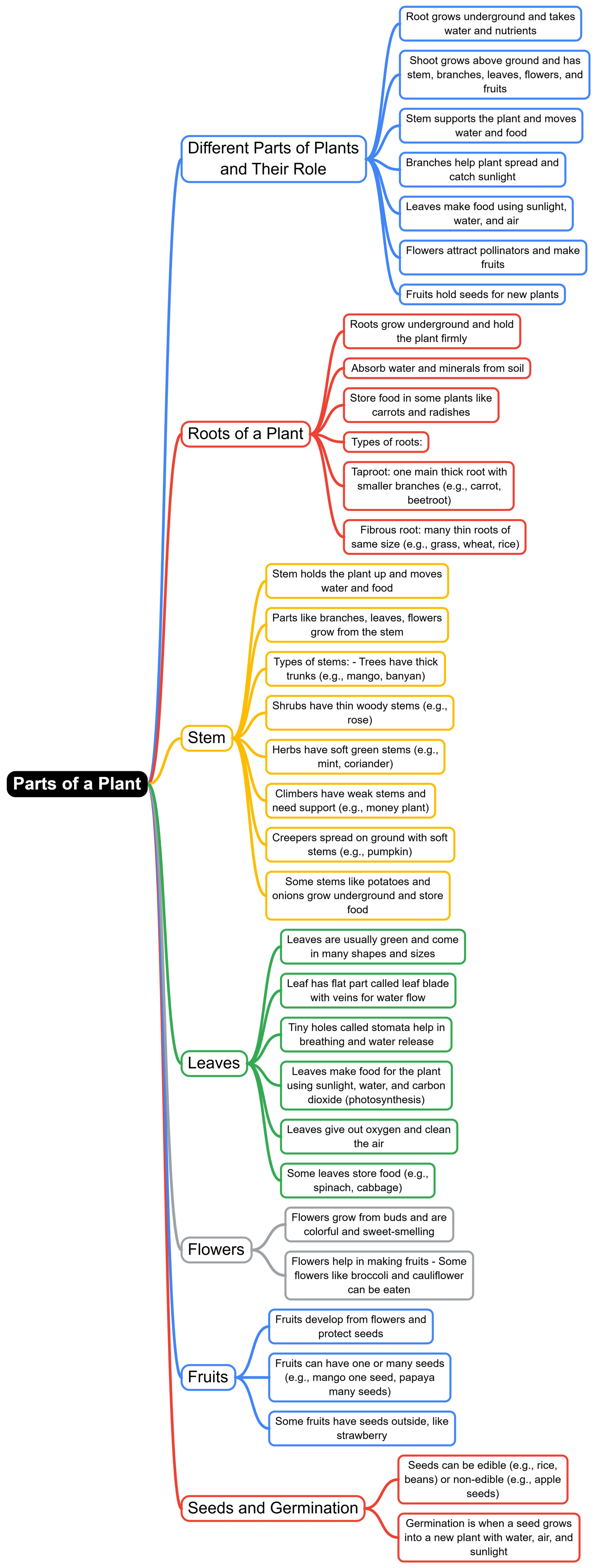Class 3 Exam > Class 3 Notes > Science for Class 3 > Mind Map: Parts of a Plant
Mind Map: Parts of a Plant | Science for Class 3 PDF Download

The document Mind Map: Parts of a Plant | Science for Class 3 is a part of the Class 3 Course Science for Class 3.
All you need of Class 3 at this link: Class 3
|
20 videos|203 docs|32 tests
|
FAQs on Mind Map: Parts of a Plant - Science for Class 3
| 1. What are the main parts of a plant and their functions? |  |
Ans. The main parts of a plant include the roots, stem, leaves, flowers, and fruits. The roots anchor the plant in the soil and absorb water and nutrients. The stem supports the plant and transports water and nutrients between the roots and leaves. Leaves are crucial for photosynthesis, where the plant converts sunlight into energy. Flowers are involved in reproduction, and fruits contain seeds that can grow into new plants.
| 2. How do roots help a plant survive? |  |
Ans. Roots play a vital role in a plant's survival by anchoring it in place, which prevents it from being uprooted by wind or rain. They also absorb water and essential nutrients from the soil, which are necessary for growth and development. Additionally, roots can store energy in the form of carbohydrates, helping the plant sustain itself during unfavorable conditions.
| 3. Why are leaves important for photosynthesis? |  |
Ans. Leaves are essential for photosynthesis because they contain chlorophyll, the green pigment that captures sunlight. During photosynthesis, leaves take in carbon dioxide from the air and water from the soil, using sunlight to convert these into glucose (a form of sugar) and oxygen. This process not only provides energy for the plant but also releases oxygen into the atmosphere, which is vital for life on Earth.
| 4. What is the role of flowers in a plant's lifecycle? |  |
Ans. Flowers are crucial for a plant's lifecycle as they are the reproductive structures. They facilitate the process of pollination, where pollen from the male part of the flower fertilizes the female ovule, leading to the formation of seeds. Flowers can attract pollinators like bees and butterflies with their colors and scents, enhancing the chances of successful reproduction.
| 5. How do fruits contribute to plant reproduction? |  |
Ans. Fruits contribute to plant reproduction by enclosing and protecting seeds. Once the seeds are fully developed, fruits help in seed dispersal, which can occur through various methods such as wind, water, or animals. This dispersal is important as it allows the seeds to grow in new locations, increasing the chances of survival and the spread of the plant species.
Related Searches
















